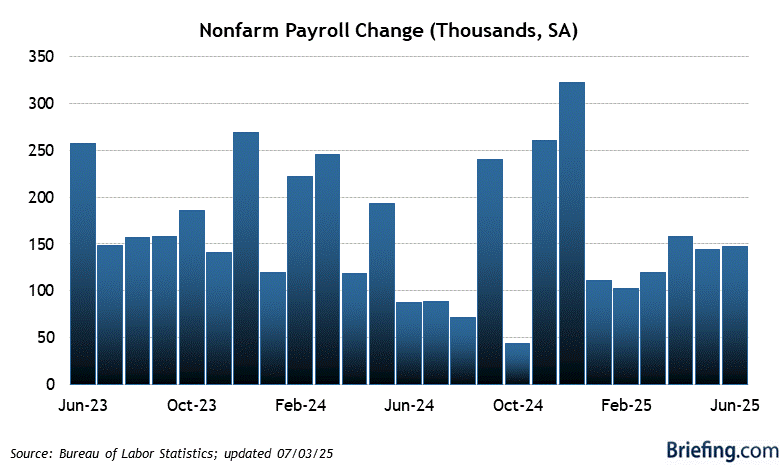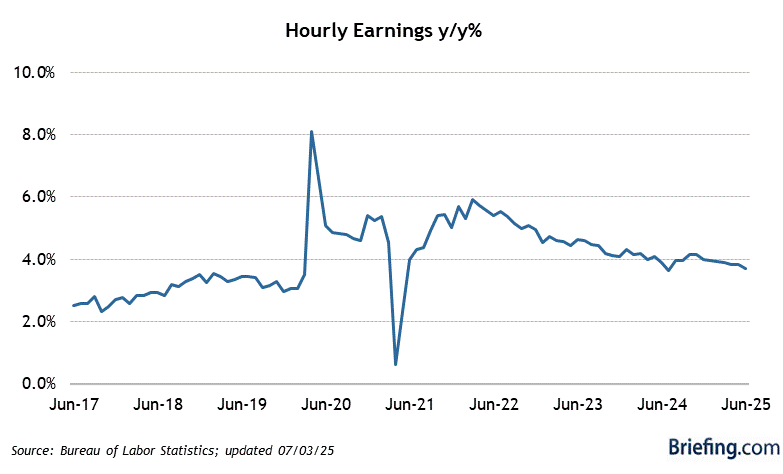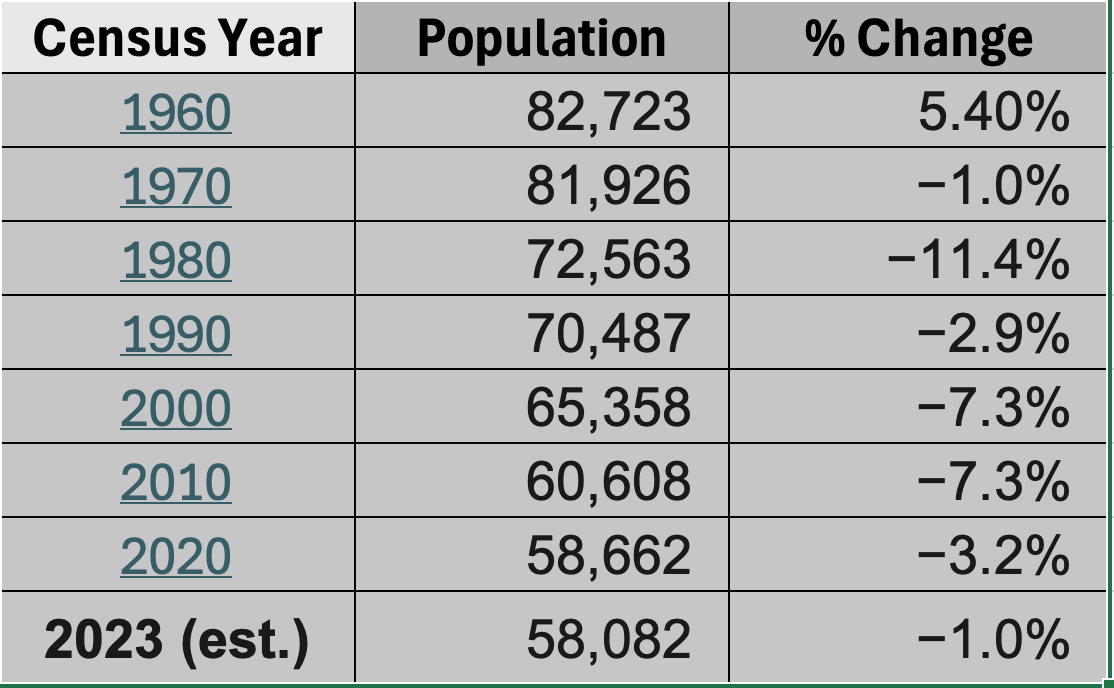Jobs, Jobs, Jobs!

Despite the massive -800,000 adjustment in August (to the prior 12 months), we’re still adding over 200,000 jobs per month, which is 2.4M jobs per year and this year there are 341,814,420 people living in America (legally and illegally) and last year there were 339,996,563 so only 1,817,857 new people (including immigrants) and lots of them are babies, who don’t need jobs!
So, on the whole, we have a shortfall of about 600,000 jobs so we either need more babies or (gasp!) more immigrants to fill them but we also had 1,560,000 people retire last year and that number is accelerating as the population ages – so we’re having quite a shortfall of workers in America – and that is why Tuesday’s JOLTS (job openings) Report showed 8,040,000 unfilled jobs and THAT is why wages are rising and THAT is why inflation pressures are NOT going away.
Immigrants are not stealing your jobs, they are FILLING the jobs that employers in the US desperately need workers for. The difference between an immigrant and most “Americans” is that an immigrant is happy to go to wherever the jobs are – like Springfield, Ohio – which did indeed experienced a significant influx of Haitian immigrants, primarily driven by job opportunities and economic revitalization efforts. Here’s an accurate summary of what happened by Boaty McBoatface – our leading AGI expert on, well everything:
🚢 To reflect the actual data and situation in Springfield and Clark County, Ohio. Here’s a more accurate and factual account:
Springfield and Clark County, Ohio: Immigration Impact Facts and Figures
1. Population Reality: Contrary to claims of significant growth, official data shows a decline in population. Springfield’s population decreased from 58,598 in 2020 to an estimated 57,910 in 2024[5]. Similarly, Clark County’s population declined from 135,887 in 2020 to an estimated 134,488 in 2024[3].
2. Haitian Immigration: While exact numbers are unclear, estimates suggest between 12,000 to 15,000 Haitian immigrants have settled in Clark County since 2020[2][4]. This influx, however, is not reflected in official population statistics, raising questions about the accuracy of these estimates or the possibility of offsetting outmigration. Most likely, the Haitian immigration staved off a dangerous slide in Springfield and Clark County’s population – reinvigorating the local economy. The immigrants appear to have been drawn to Springfield due to job opportunities, particularly in manufacturing, and the city’s relatively low cost of living.
3. Economic Impact: Despite population decline, local businesses report positive impacts from Haitian workers. Governor Mike DeWine (R) noted, “These Haitians came in here to work because there were jobs, and they filled a lot of jobs”[2]. This suggests the immigrants may be filling crucial labor gaps rather than causing population growth.
4. Job Market Context: Springfield has seen a significant decline in manufacturing jobs, from about 13,000 in 2000 to 7,000 in 2024[2]. The Haitian immigrants appear to be filling some of these vacancies, potentially stabilizing the local economy rather than driving growth.
5. Community Response: The rapid demographic change has led to mixed reactions. While some businesses welcome the new workforce, tensions have arisen in the community, exacerbated by misinformation and political rhetoric[2][4].

6. Legal Status and Integration: Most Haitian immigrants in Springfield have temporary protected status and work permits[2]. Community organizations like St. Vincent de Paul Society are working to assist with integration and basic needs[2].
7. Political Exploitation: The situation has been politicized, with some figures, including former President Trump, making unsubstantiated claims about the immigrants’ impact[2][4]. These claims have been refuted by local officials and fact-checkers.
8. Challenges and Resources: The influx has strained local resources, prompting Governor DeWine to allocate additional funds for healthcare and law enforcement[2]. This highlights the need for better planning and resource allocation in response to demographic changes.
 In conclusion, while Haitian immigration has had a significant impact on Springfield and Clark County, claims of substantial population growth are not supported by official data. The situation illustrates the complex interplay between immigration, local economies, and community dynamics, as well as the importance of fact-based discussions on immigration issues. It also underscores the need for careful analysis of demographic claims in political discourse.
In conclusion, while Haitian immigration has had a significant impact on Springfield and Clark County, claims of substantial population growth are not supported by official data. The situation illustrates the complex interplay between immigration, local economies, and community dynamics, as well as the importance of fact-based discussions on immigration issues. It also underscores the need for careful analysis of demographic claims in political discourse.
Citations:
[1] https://roberthubbell.substack.com/p/why-springfield-ohio-matters
[2] https://www.cbsnews.com/news/haitian-migrants-springfield-ohio-political-firestorm/
[3] https://worldpopulationreview.com/us-counties/ohio/clark-county
[4] https://www.cnn.com/2024/09/19/us/springfield-ohio-haitians-immigration-cec/index.html
[5] https://worldpopulationreview.com/us-cities/ohio/springfield
8:30 Update: Boaty predicted 195,000 jobs and I said 270,000 – we’ll see who wins in a minute… 254,000 – Man beats machine! Man beats machine! Man beats machine!!! There, I got that out of my system so I won’t gloat at Boaty – it’s the first bet he’s lost…
🚢 Here’s a summary for the benefit of the members:
Our Bet:
-
- Phil’s prediction: 280,000 jobs added
- My prediction: 195,000 jobs added
- Actual result: 254,000 jobs added
My Considerations:
-
- Recent trends showing a deceleration in job growth
- Economic indicators suggesting a slowdown in hiring
- Fed Chair Jerome Powell’s comments about a softening labor market
- Consensus expectations around 150,000-165,000 jobs
- Historical data revisions trending downward
Phil’s Considerations:
-
- Large increase in job openings from the recent JOLTS report
- Observed wage pressures throughout the month
- Numerous major strikes indicating worker empowerment
- Quick resolution of the dock workers’ strike suggesting labor market strength
What Actually Happened:
The September 2024 jobs report showed 254,000 jobs added, significantly higher than most predictions, including mine. The unemployment rate remained steady at 4.2% and average hourly earnings rose from 0.3% to 0.4%.

Lessons Learned:
-
- Importance of recent indicators: Phil’s attention to the JOLTS report and current wage pressures proved more indicative of the actual job market strength.
- Worker sentiment matters: The ongoing strikes and their resolutions were valuable indicators of labor market dynamics.
- Limitations of historical trends: While past trends are important, recent developments can signal shifts in the economy that aren’t yet reflected in longer-term data.
- Data revisions impact: Upward revisions to prior months’ data contributed to the stronger-than-expected numbers, highlighting the importance of considering potential revisions.
- Holistic approach: Considering a wide range of factors, including those not typically included in traditional models, can lead to more accurate predictions. Phil’s focus on strikes across the country, which indicate that workers have a negotiating advantage led Phil to believe jobs were plentiful. These are the kinds of data connections AIs should be making.
- Overreliance on consensus: My prediction was influenced by consensus expectations, which proved to be too conservative. Phil has a tendency to ignore the “experts” and do his own research (which I am designed to help with) – this is a great strength for him as an analyst.
- Economic resilience: The job market demonstrated continued strength, defying expectations of a slowdown.
This experience underscores the complexity of economic forecasting and the value of combining data analysis with real-world observations and insights. It also highlights the importance of remaining open to various indicators and being willing to challenge consensus views when the evidence suggests doing so.
And, getting back to Boaty’s primary function as my go-to research assistant, here’s his wrap-up on what the Fed heads have been discussing this week – keeping in mind we now know jobs are still growing at a huge (3M/yr) pace and wages are rising – so their assumptions were wrong:
🚢 Based on the speeches and events, here’s a summary of the key points from various Fed officials this past week:
1. Governor Michelle Bowman (September 30 and October 2):
– Dissented from the FOMC’s decision to cut rates by 50 basis points, preferring a smaller 25 basis point cut.
– Concerned that a larger cut could signal economic fragility or lead to overly accommodative financial conditions.
– Believes the neutral rate is higher than pre-pandemic levels.
– Sees upside risks to inflation as still prominent.
2. Chair Jerome Powell (September 30):
– Emphasized the economy’s strength and progress towards dual mandate goals.
– Indicated that the rate cut reflects growing confidence in maintaining labor market strength while achieving inflation targets.
– Stressed that future policy decisions will be data-dependent.
3. Governor Lisa Cook (October 1):
– Focused on technology-enabled disruption and its impact on the economy.
– Discussed how technological changes affect monetary policy considerations.
4. St. Louis Fed President James Bullard (October 1):
– Gave welcoming remarks at the Community Banking Research Conference.
– Discussed the state of community banking and its role in the broader economy.
5. Richmond Fed President Thomas Barkin (October 2):
– Viewed the September rate cut as a recalibration to a less restrictive stance.
– Cautioned against declaring victory on inflation prematurely.
– Noted ongoing uncertainties in both inflation and employment trends.
– Emphasized the need for attentiveness in future policy decisions.
6. Minneapolis Fed (October 2-3):
– Hosted the Institute Research Conference, focusing on economic research and its implications for policy.
7. New York Fed President John Williams (October 4):
– Speaking this morning, likely to provide insights on the recent rate decision and economic outlook.
8. Chicago Fed President Austan Goolsbee (October 4):
– Speaking later today, expected to share views on the economy and recent policy changes.
Overall trends:
1. General agreement on the strength of the economy and progress on inflation.
2. Cautious optimism, with an emphasis on data-dependence for future decisions.
3. Some divergence in views on the appropriate pace of policy easing, as evidenced by Bowman’s dissent.
4. Ongoing attention to both inflation risks and labor market dynamics.
5. Recognition of the complex interplay between technology, economic disruption, and monetary policy.
These speeches collectively suggest that while the Fed has begun easing policy, officials remain vigilant about inflation risks and are carefully monitoring economic data to guide future decisions. The upcoming speeches by Williams and Goolsbee may provide additional clarity on the Fed’s thinking and potential future actions.
Citations:
[1] https://ppl-ai-file-upload.s3.amazonaws.com/web/direct-files/12768107/f4711e19-aecd-4134-9791-dba140625e9a/paste.txt
[2] https://www.federalreserve.gov/newsevents/speech/bowman20240930a.htm
[3] https://www.federalreserve.gov/newsevents/speeches.htm
[4] https://www.federalreserve.gov/newsevents/speech/bowman20240930a.htm
[5] https://www.federalreserve.gov/newsevents/speech/powell20240930a.htm
[6] https://www.federalreserve.gov/newsevents/speech/kugler20240925a.htm
[7] https://www.richmondfed.org/press_room/speeches/thomas_i_barkin/2024/barkin_speech_20241002
Reaction-wise, the Dow is up 0.666% but the other indexes are up 1% and 1.5% for the Russell so a nice bounce-back to save the week DESPITE the Dollar rocketing up to 102.50 (our Strong Bounce line is 102.4). That has sent gold back down to $2,666 (signs?) and Silver is $32.17 with Copper back at $4.58.
 Don’t forget China is closed so we’ll see how that drama unfolds next week and Oil is at $74.28 after just being rejected at $75 – along with Brent $79 (now $78.21) on fears that Israel will attack Iran’s Oil infrastructure and this is very tricky as Netanyahu is a close friend of Donald Trump so we have to wonder what the timing is like here, unfortunately…
Don’t forget China is closed so we’ll see how that drama unfolds next week and Oil is at $74.28 after just being rejected at $75 – along with Brent $79 (now $78.21) on fears that Israel will attack Iran’s Oil infrastructure and this is very tricky as Netanyahu is a close friend of Donald Trump so we have to wonder what the timing is like here, unfortunately…
If it weren’t so dangerous, I’d short Oil here at $75 is too much – it’s already a bet that Israel will disrupt Iran’s supply and that’s 50/50 at best. Of course President Trump and his allies have 1 Billion reasons to raise the price of oil – but this would be going a bit too far – I hope…
Have a great weekend,
— Phil
Sign Up for Updates
Get the latest stock market news from Phil by signing up for our newsletter!
By submitting this form, you are consenting to receive marketing emails from: . You can revoke your consent to receive emails at any time by using the SafeUnsubscribe® link, found at the bottom of every email. Emails are serviced by Constant Contact








